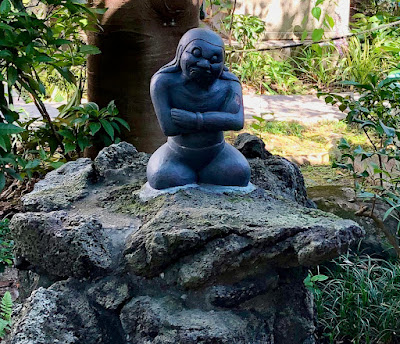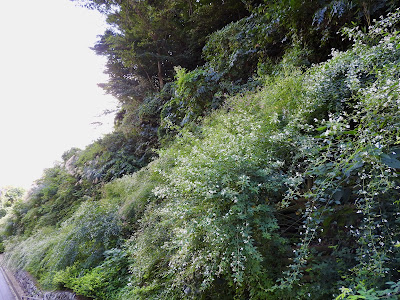目次 / Contents
1) 歴史 / History
2) 境内 / Precincts
3) 造形物 / Sculpted Objects
4) 庭 / Garden
5) 東結界側参道 / Approach East Bai Sema Side
1) 歴史 / History
9月は、夫Rの誕生日・月で、今日は、二人で、
'バースディ・ウォーク' をしています。
成就院は、鎌倉市極楽寺にある真言宗大覚寺派 (シンゴンシュウダイカクジハ)の寺院です。
三代執権の北条 泰時 (ホウジョウ ヤストキ / 1183 - 1242 / 在位:1224 -1242) がこのお寺を創建しました。
1333年、新田 義貞 (ニッタ ヨシサダ / 1301 -1338) の
1688年 (江戸時代) に元の地に再建されました。
 |
| 極楽寺方面から由比ヶ浜方面に抜ける、 極楽寺坂切通 (ゴクラクジザカキリドウシ)の途中に 成就院はあります。 There is Jojuin Temple in the middle of the Gokuraku Pass which runs from Gokuraku-ji area to Yuigahama Beach.  |
History
September is my husband R's Birthday Month, and we had his birthday walk today.
This section is about Jojuin Temple.
Walk before Jojuin Temple, below.
Hōjō Yasutoki (1183 - 1242 / reign : 1224 - 1242), the third
Shikken (regent) of the Kamakura shogunate, founded this temple.
In 1333, it was burnt down in the battle of
Nitta Yoshisada (1301 - 1338) attacking Kamakura
(Siege of Kamakura ) and moved to Nishigaya.
It was rebuilt in the original land, here in 1688 (Edo period).
2) 境内 / Precincts
 |
| 西結界 '結界'という言葉を門に使用していることに 新鮮な驚きを感じました。 West Bai Sema I was freshly surprised to use the word 'Bai Sema' for the gate.  8:00 AM opening ~ 5:00 PM closing Winter season 1st of November - 1st of March : PM 4:30 Gate closed. |
 |
| 西結界から参道へ進み、地蔵菩薩の案内を見ました。 道(極楽寺坂切通)を挟んだ向こうの敷地 (墓地?) に あるようでした。 山門の中へ入ってから気がつくのですが、 このお寺は造形物を加えて行くのが好きな傾向があります。 We went to the approach from West Bai Sema and saw the information of Kṣitigarbha. It seemed to be on the site (graveyard?) across a road (Gokuraku Pass). As I would notice after entering Sanmon Gate, this temple tends to like to add Sculpted Objects  地蔵菩薩 像 写真を撮影し、お参りには行きませんでした。 Statue Kṣitigarbha I took a picture and we didn't go to visit. |
 |
| 山門 西結界と東結界からの参道の先に山門があります。 Sanmon Gate There is the Sanmon Gate at the end of approaches from the West Bai Sema and the East Bai Sema. |
 |
| 本堂 本尊は不動明王 (フドウミョウオウ) です。 本堂前からでは、中の様子は見えませんでした。 不動明王は多くの寺で祀られています。 地元の不動明王は、'お不動さん' と 呼ばれて親しまれている気がします。 梵名のアチャラナータは、'揺るぎなき守護者' の意味 なのだそうで、地元の人に親しまれる存在であることに 納得が行きます。 Main Hall The principal image is Acala (Acalanātha) : Fudo-Myouou. From the front of the main hall, I couldn't see the inside. In Japan, Acala is enshrined in many temples. I feel that the local Acala is known as 'O Fudo-san ; Mr. Acala'. It seems that Sanskrit name, Acalanātha means 'Unwavering Guardian', and I am convinced that it is familiar to the locals. |
3) 造形物 / Sculpted Objects
 |
| 弘法大師 像 弘法大師 (コウボウダイシ / 空海 / クウカイ / 774 - 835) は、 中国より真言密教を日本へ伝え 真言宗の開祖 (宗祖) となりました。 真言宗は分派が多く、このお寺は真言宗大覚寺派ですが 私には違いはよくわかりません。 宇宙の真理や神の御心を未熟な人間が理解しようと 何千年も模索しています。 私に理解できなくて当然に思えます。 Kōbō Daishi Statue Kōbō Daishi (Kūkai / 774 - 835) brought Shingon Esoteric Buddhism. from China to Japan and became the founder of There are many branches of the Shingon sect, and this temple is the Shingon sect Daikakuji sect, but I don't really understand the difference. For thousands of years, humans have sought to understand the truth of the universe or the will of God. It seems natural that I don't understand. |
 |
| 八角の小堂 聖徳太子 (574 - 622) 1300年忌に建てられた八角の小堂です。 私には聖徳太子とこのお寺の繋がりがわかりません。 聖徳太子が日本に仏教を広めたことへの感謝でしょうか? Octagonal Small Hall It is an octagonal small hall built on the 1300th anniversary of Prince Shōtoku (574 - 622) . I don't know the connection between Prince Shotoku and this temple. Is it thanks to Prince Shotoku for spreading Buddhism in Japan? |
複数の像が配置されています。
テースト的に従来の像と全く異なる、新しい像、'なで蛙' が
追加されていました。(ここに写真は載せません)
なんとなく、私には居心地がよくは感じられない空間でした。
参道に最も人気が出るのがわかる気がします。
Although the precincts are not very large, a few statues are set.
A new image, 'Nade Frog : Touch Frog', which is completely different from the conventional images in terms of taste, has been added. (I don't show a photograph of it here.)
Somehow, here is a space that I didn't feel comfortable with.
I can see that the approach is the most popular.
 |
| 文覚上人荒行像 (ブロンズ) Mongaku Shonin Asceticisms Statue (Bronze) 文覚 (モンガク / 1139 - 1203) は、武士・真言宗の僧です。 文覚は、 源 頼朝 (1147 -1199 / 鎌倉将軍在位:1192 -1199)と 親交があり、宗教のみだけでなく政治的に活動しました。 純粋な僧ではなかったと私は感じています。 この像はレプリカです。 本物がどこにあるのかわかりません。 木像文覚(おそらく本物)は 彫刻家、荻原 碌山 (オギワラ ロクザン / 1879 -1910) に 影響を与えたと言われています。 碌山 は、彼の '文覚像 ' (1908) を制作し、 これは彼の代表作の1つです。  文覚上人荒行像 (ブロンズ) Mongaku Shonin Asceticisms Statue (Bronze) Mongaku had a close relationship with Minamoto no Yoritomo (1147 - 1199 / Kamakura shogunate reign : 1192 -1199) and was active not only in religion but also in politics. I feel he was not a pure monk. This statue is a replica. I don't know where the real thing is. The wooden statue Mongaku (probably the real thing) is said to have influenced a sculptor, Rokuzan Ogiwara (1879 - 1910). Rokuzan made his own work: Mongaku Statue, 1908, this is one of his masterpieces. |
私には、'文覚上人荒行像' (ブロンズ像) のアート要素がよくわかりません。
ですが、少なくとも荻原 碌山に彼自身の文覚像 (下の画像) を作らせる動機になったことはよかったと思います。
I don't really understand the artistic elements of 'Mongaku Shonin Asceticisms Statue' (Bronze).
But at least I'm glad that it motivated Rokuzan Ogiwara to make his own 'Mongaku Statue', below.
 |
| '文覚像 ' (1908) 荻原 碌山 作 所蔵、碌山美術館 この像を見ると、成就院の文覚像が反面教師のように 碌山に影響を与えたのではないかと思います。 そう感じるのは私だけでしょうか? 'Mongaku Statue' (1908) By Rokuzan Ogiwara Looking at this statue, I think that 'Mongaku Statue' of Jojuin Temple influenced Rokuzan as negative example. Am I the only one who feels that way? Collection, Rokuzan Art Museum 画像は下記より / This from below ★ |
D. 庭 / Garden
E. 東結界側参道
Approach East Bai Sema Side
 |
| 参道沿いの岩壁 苔やシダが素敵。 鎌倉の湿気も感じます。 Rock Wall Along Approach The moss and ferns are lovely. I also feel the humidity in Kamakura. |
 |
Jojuin Temple was famous as 'Hydrangea Temple' for a long time, but since 2019, the approach has been replanted from Hydrangea to Hagi : Japanese Clovers : Lespedeza. |
 |
| 萩は、秋の七草のひとつです。 秋の七草はこちら→★ Hagi is one of Seven Autumn Herbs. Click here for Seven Autumn Herbs. → ★ |
 |
| 東結界 私達は、西結界から入り、東結界から出ました。 East Bai Sema We entered from the West Bai Sema and exited from the East Bai Sema. |
この後、極楽寺坂切通沿いにある虚空蔵堂 (コクゾウドウ) に行きました。
虚空蔵堂は、成就院が管理しています。
なので、このセクションへ入れたかったのですが、このセクションが長くなったので次のセクションへ持ち越しました。
After this, we visited Kokuzo-do Hall along Gokuraku Pass.
Kokuzo-do Hall is managed by Jojuin Temple.
So I wanted to put it in this section, but since this section became long, I carried it over to the next section.

















0 件のコメント:
コメントを投稿